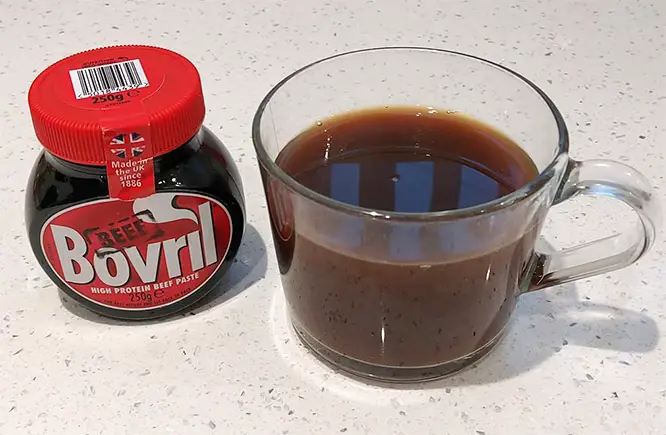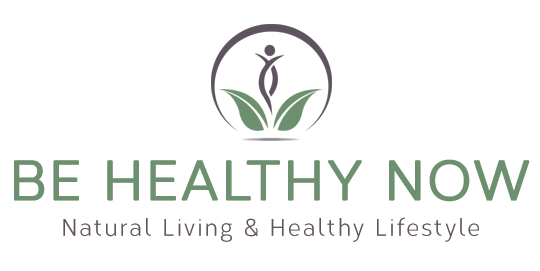Recently updated on April 11th, 2024 at 10:17 pm
Ever wondered if Bovril, that comforting staple in your kitchen, is actually good for your health? It’s a question many of us ask while enjoying this unique beverage.
In this post, we dive into the world of Bovril, examining its ingredients and health benefits to provide clear answers. Join us as we explore whether Bovril is a friend or foe to your wellbeing.

Ingredients in Bovril
Bovril has long been a familiar name in many households, known for its rich, savoury flavour. But what exactly goes into this jar of comforting paste? Let’s take a closer look at the key ingredients that make up Bovril and discuss any components that might raise an eyebrow.
Key Ingredients in Bovril:
- Beef Broth (50%): This forms the base of Bovril, made from water and beef bones. It’s responsible for the deep, meaty flavor that Bovril is famous for.
- Yeast Extract (27%): Containing barley, wheat, oat, and rye, the yeast extract adds a unique umami flavor and is a significant source of B-vitamins.
- Salt: Used for flavoring and preserving the product, salt is a key but simple ingredient in Bovril.
- Colour (Ammonia Caramel): This adds the distinct dark color to Bovril. Ammonia caramel is a common food coloring and is generally considered safe.
- Corn Starch: Used as a thickener, corn starch gives Bovril its spreadable consistency.
- Beef Powder (1%): Enhancing the beefy taste, beef powder is a concentrated form of beef flavor.
- Flavourings (Contain Celery): These are added to enrich the overall taste profile of Bovril.
- Flavour Enhancers (Disodium Inosinate, Disodium Guanylate): These additives enhance the savory taste of Bovril.
- Acid (Lactic Acid): A natural acid that helps balance the flavors.
Noteworthy Ingredients:
- Allergens: Bovril contains barley, wheat, oat, rye, and may contain milk, egg, soy, and mustard. This is important for those with allergies or intolerances.
- Flavour Enhancers: The use of disodium inosinate and disodium guanylate, while common in many processed foods, might be a concern for some people who prefer natural flavours.
- Salt Content: The presence of salt, necessary for flavour and preservation, can be a point of consideration for those monitoring their sodium intake.
In summary, Bovril’s composition is a mix of beef-derived ingredients, yeast extract, and flavour enhancers. While it caters to the taste buds of meat lovers, individuals with specific dietary needs or health concerns should take note of its allergens and sodium content.
General Nutrition Information
Bovril’s nutritional profile per serving is quite distinctive:
- Calories: 30 kcal, or 2% of the daily recommended intake.
- Fat: Less than 0.5 g, roughly 1% of daily intake.
- Saturated Fat: Less than 0.1 g, about 1% of the daily value.
- Carbohydrates: 2.8 g, constituting 1% of your daily needs.
- Sugars: Less than 0.5 g, 1% of the recommended daily amount.
- Fibre: Less than 0.5 g per serving.
- Protein: 4.6 g, making up 9% of the daily requirement.
- Salt: 1.4 g per serving, which is 23% of the daily recommended intake.
The key takeaway is Bovril’s high protein content and significant salt level. With low fat, carbohydrates, and sugars, it offers a unique nutritional composition.
Salt Content in Bovril
When it comes to salt content, Bovril is quite noteworthy. Let’s delve deeper into how much salt is in different Bovril products:
- Per Cup of Bovril (Drink): Typically, a cup of Bovril drink contains about 2.8 g of salt, which is almost half of the recommended daily salt intake.
- Per Teaspoon of Bovril (Paste): A single teaspoon of Bovril paste has approximately 0.28 g of salt.
Comparing these values with the daily recommended salt intake, which is around 6 g for adults, it’s clear that Bovril is high in salt. Consuming Bovril in moderation is key, especially for those who are monitoring their sodium intake for health reasons such as hypertension.
The high salt content in Bovril, while contributing to its distinctive taste, can have significant health implications if consumed in large quantities. High salt intake is associated with increased risk of hypertension and cardiovascular diseases. Therefore, it’s crucial to consider how much Bovril you consume, especially if it forms a regular part of your diet.
In conclusion, while Bovril’s high protein content might be beneficial, its salt content warrants careful consideration. Balancing its consumption with other low-sodium foods is essential for maintaining a healthy diet.
Is Bovril Good or Bad for You?
Bovril, with its unique taste and nutritional profile, has both benefits and potential downsides. Let’s break down the pros and cons to see how it might impact your health.
Benefits:
- High in Protein: With 4.6 g of protein per serving, it’s a good option for protein intake.
- Low in Fat and Sugars: Bovril contains minimal amounts of fat and sugars, making it a suitable choice for those watching their calorie intake.
- Potential Weight Loss Aid: Due to its low-calorie count and high protein content, Bovril can be a part of a weight loss diet, especially when used as a low-calorie snack or meal replacement.
- Rich in B-Vitamins: Thanks to the yeast extract, it provides a good source of B-vitamins, essential for energy production and overall health.
Potential Downsides:
- High Salt Content: The significant amount of salt could contribute to high blood pressure and other heart-related issues.
- Risk for Heart Health: Due to its high sodium content, Bovril might not be ideal for those with or at risk of heart disease.
- Liver Health Concerns: High sodium intake can also put a strain on liver function, especially in individuals with existing liver conditions.
- Digestive Effects: Some individuals might experience digestive discomfort, such as diarrhea or constipation, especially if consumed in large quantities.
- Allergy Concerns: The presence of allergens like barley, wheat, oat, rye, and others could pose a risk for those with specific food allergies.
Final Verdict:
In conclusion, Bovril can be both good and bad for your health. It’s good in terms of being a high-protein, low-fat option with valuable B-vitamins. However, the bad comes from its high salt content, posing risks to heart and liver health and potentially causing digestive discomfort.
Bovril should be consumed in moderation, especially by individuals with heart conditions, liver issues, or specific dietary needs. It’s a product that requires a careful balance in your diet to reap its benefits without experiencing the downsides.
FAQs
Is Bovril on Toast Good for You?
Bovril on toast combines the savoury flavour of Bovril with the nutritional profile of the bread used. A typical slice of wholegrain toast has about 70-80 calories. Adding a thin spread of Bovril (approximately one teaspoon) adds about 30 calories from the Bovril, totalling around 100-110 calories for the snack. The protein content from Bovril and the fibre from wholegrain bread make it a nutritious option.
Verdict: Bovril on toast can be a nutritious and satisfying snack, particularly with wholegrain or wholemeal bread. It’s high in protein and, if you choose the right type of bread, can also be a good source of fiber. However, be mindful of the salt content, especially if consuming Bovril regularly.
Are Bovril Cubes Good for You?
Determining whether Bovril cubes are good for you depends largely on your individual dietary needs and health concerns. Nutritionally, Bovril cubes share a similar profile to the liquid form of Bovril, primarily offering a good source of protein and B-vitamins, while also being low in fat and sugars. However, like the liquid version, they are high in salt content.
For those looking for a convenient way to add rich, meaty flavor to their dishes, Bovril cubes can be a good choice. They can be particularly useful in enhancing the taste of soups, stews, and broths, where they dissolve easily. The high protein content in Bovril cubes can be beneficial, especially for those needing to increase their protein intake.
However, the high salt content is a significant factor to consider. If you have health concerns related to sodium intake, such as hypertension or heart disease, or if you are generally aiming to reduce your sodium consumption, then Bovril cubes might not be the best option for you.
Can Bovril be Consumed While Fasting?
This depends on the type of fasting. If you’re doing intermittent fasting that allows for zero-calorie liquids, then Bovril, especially in its drink form, would break the fast due to its calorie content.
Verdict: It’s best to avoid Bovril if you’re strictly fasting, but for less restrictive fasts, a small amount might be acceptable.
Is Bovril Good for Diabetics?
Bovril’s low sugar content is a positive for diabetics. However, the high salt content could be a concern, especially if there are co-existing conditions like hypertension.
Verdict: Diabetics can consume Bovril in moderation, but it’s advisable to consult with a healthcare provider, considering the overall diet and health status.
Is Bovril Good for Your Skin?
Bovril contains beef broth, which is known to have potential benefits for the skin, primarily due to the collagen content in bone broth. Collagen has been associated with improving skin elasticity and overall skin health.
However, the amount of beef broth in Bovril is about 50% of the product, and it’s important to note that during the process of making Bovril, the broth is concentrated and processed. This process might alter or reduce the amount of collagen or other beneficial nutrients compared to homemade bone broth.
Additionally, the other ingredients in Bovril, particularly the high salt content, could counteract any potential benefits for the skin by contributing to dehydration, which can negatively affect skin health.
In conclusion, while beef broth itself has properties that can benefit skin health, it’s uncertain how much of these benefits are retained in Bovril due to its processing and the proportion of broth in the product. Additionally, the high salt content in Bovril might offset any potential skin benefits.
Therefore, relying on Bovril for skin health benefits might not be as effective as consuming homemade bone broth or other sources of collagen.


